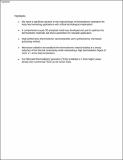| dc.contributor.author | Lebeau, James M | |
| dc.date.accessioned | 2020-10-01T17:37:34Z | |
| dc.date.available | 2020-10-01T17:37:34Z | |
| dc.date.issued | 2020-01 | |
| dc.date.submitted | 2019-10 | |
| dc.identifier.issn | 2211-2855 | |
| dc.identifier.uri | https://hdl.handle.net/1721.1/127789 | |
| dc.description.abstract | Body heat harvesting systems based on thermoelectric generators (TEGs) can play a significant role in wearable electronics intended for continuous, long-term health monitoring. However, to date, the harvested power density from the body using TEGs is limited to a few micro-watts per square centimeter, which is not sufficient to turn on many wearables. The thermoelectric materials research has been mainly focused on enhancing the single parameter zT, which is insufficient to meet the requirements for wearable applications. To develop TEGs that work effectively in wearable devices, one has to consider the material, device, and system requirements concurrently. Due to the lack of an efficient heatsink and the skin thermal resistance, a key challenge to achieving this goal is to design systems that maximize the temperature differential across the TEG while not compromising the body comfort. This requires favoring approaches that deliver the largest possible device thermal resistance relative to the external parasitic resistances. Therefore, materials with low thermal conductivity are critically important to maximize the temperature gradient. Also, to achieve a high boost converter efficiency, wearable TEGs need to have the highest possible output voltage, which calls for a high Seebeck coefficient. At the device level, dimensions of the legs (length versus the base area) and fill factor are both critical parameters to ensure that the parasitic thermal resistances are again negligible compared to the resistance of the module itself. In this study, the concurrent impact of material and device parameters on the efficiency of wearable TEGs is considered. Nanocomposite thermoelectric materials based on bismuth telluride alloys were synthesized using microwave processing and optimized to meet the requirements of wearable TEGs. Microwave energy decrystallized the material leading to a strong reduction of the thermal conductivity while maintaining a high zT at the body temperature. A comprehensive quasi-3D analytical model was developed and used to optimize the material and device parameters. The nanocomposite TEG produced 44 μW/cm2 under no air flow condition, and 156.5 μW/cm2 under airflow. In comparison to commercial TEGs tested under similar conditions, the nanocomposite based TEGs exhibited 4–7 times higher power density on the human body depending on the convective cooling conditions. | en_US |
| dc.description.sponsorship | United States. Air Force. Office of Scientific Research (Contract FA9550-12-1-0225) | en_US |
| dc.description.sponsorship | National Science Foundation (U.S.) (Grants EEC-1160483, ECCS-1351533, ECCS-1711253, and CMMI-1363485) | en_US |
| dc.language.iso | en | |
| dc.publisher | Elsevier BV | en_US |
| dc.relation.isversionof | 10.1016/j.nanoen.2019.104265 | en_US |
| dc.rights | Creative Commons Attribution-NonCommercial-NoDerivs License | en_US |
| dc.rights.uri | http://creativecommons.org/licenses/by-nc-nd/4.0/ | en_US |
| dc.source | Prof. LeBeau via Ye Li | en_US |
| dc.title | Thermoelectric generators for wearable body heat harvesting: Material and device concurrent optimization | en_US |
| dc.type | Article | en_US |
| dc.identifier.citation | Nozariasbmarz, Amin et al. “Thermoelectric generators for wearable body heat harvesting: Material and device concurrent optimization.” Nano Energy, 67 (January 2020): 104265 © 2020 The Author(s) | en_US |
| dc.contributor.department | Massachusetts Institute of Technology. Department of Materials Science and Engineering | en_US |
| dc.relation.journal | Nano Energy | en_US |
| dc.eprint.version | Author's final manuscript | en_US |
| dc.type.uri | http://purl.org/eprint/type/JournalArticle | en_US |
| eprint.status | http://purl.org/eprint/status/PeerReviewed | en_US |
| dc.date.updated | 2020-09-30T12:25:07Z | |
| dspace.orderedauthors | Nozariasbmarz, A; Suarez, F; Dycus, JH; Cabral, MJ; LeBeau, JM; Öztürk, MC; Vashaee, D | en_US |
| dspace.date.submission | 2020-09-30T12:25:13Z | |
| mit.journal.volume | 67 | en_US |
| mit.license | PUBLISHER_CC | |
| mit.metadata.status | Complete | |
